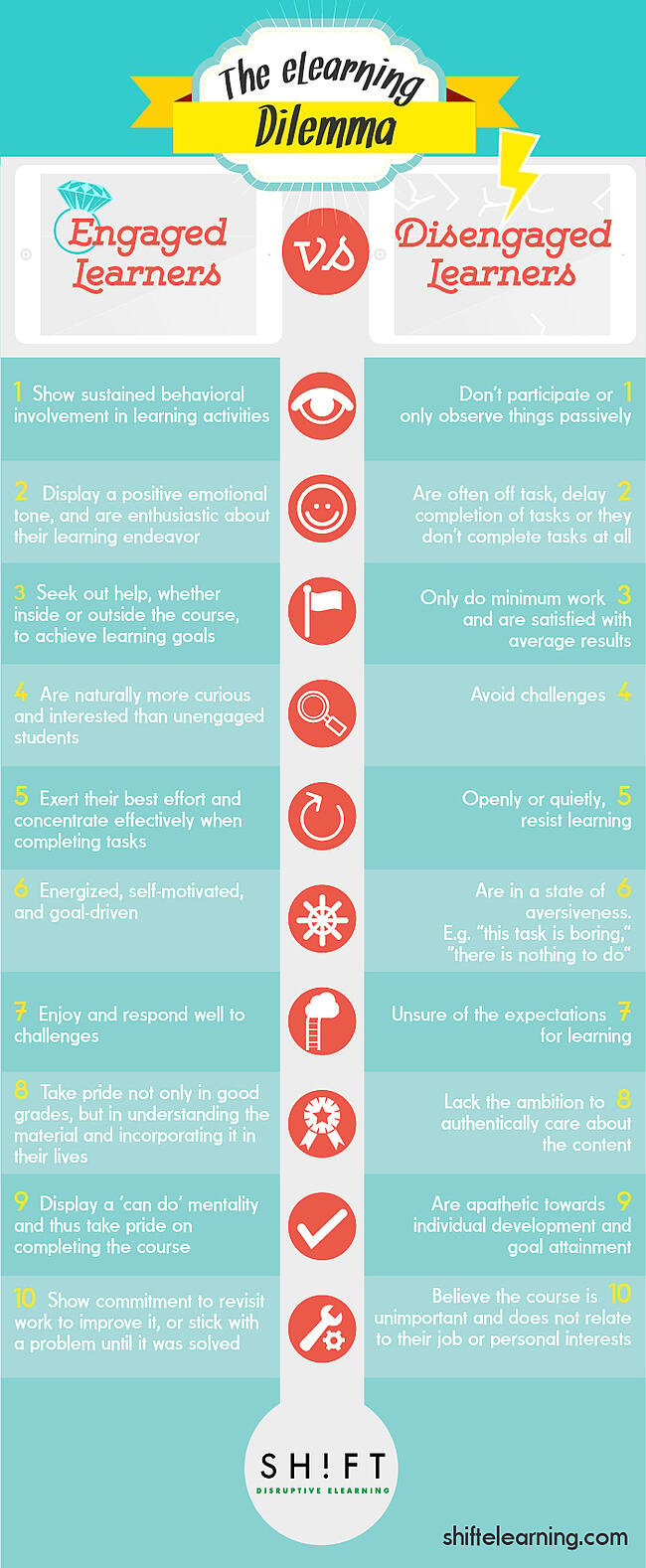Engaging the unengaged has always been an elusive goal among learning professionals. While there are challenges related to student engagement in other learning environments, online curriculum may include added obstacles. Problems revolve around the lack of personal interaction between the instructor and student, as well as the student-to-student contact. The eLearning environment can be isolating and prone to distraction. Long story short, engagement has always been a crucial component of learning—if not the first step to learning.
The proverbial questions are: what makes a learner engaged or unengaged? How do we make sure learners stay engaged, especially when something more exciting than their course is only a click away? To find the answers, we first need an in-depth look at the issue of engagement.
Unengagement: the Biggest Challenge of Them All
It's no secret trainers and educators consider disengaged students as one of the most challenging issues in their profession. As many as 25 percent to more than half of students are now disengaged. They're quickly bored with lectures and materials. Their "immersion in technology" is one of the known culprits.
Today's students cling to the mobile devices. Their eyes are often glued to screens of all sizes and are presented with interactive and engaging visuals—from Instagram photos to YouTube videos. They are hardwired to multitask. This isn't an assumption but a reality.
Expecting learners to sit still at their desks and be attentive for two hours a day, listening to content they deem unimportant is a recipe for failure. If students in your eLearning programs find it difficult to pay attention or participate in an activity, if they can see no purpose, relevance or connection to the learning material, then they're likely become disengaged.
Here's a quick list of items that best describes this "unengaged" group:
- Are often off task, delay completion of tasks or they don't complete tasks at all.
- They don't participate or only observe things passively.
- They only do minimum work and are satisfied with average results.
- They avoid challenges.
- They, openly or quietly, resist learning.
- They're in a state of aversiveness (e.g., “this task is boring,” “there is nothing to do”).
- Unsure of the expectations for learning.
- Lack the ambition to authentically care about the content.
- Are apathetic towards individual development and goal attainment.
- Believe the course is unimportant and does not relate to their jobs or personal interests.
Engagement: The Essential Elements of an Engaged Learner
Engagement is generally defined as the level of participation and intrinsic motivation a student displays in a learning environment. It's also referred as “the amount of physical and psychological energy that the student devotes to the academic experience.”
When it comes to learner engagement, it involves both behaviors (such as persistence, effort, attention) and attitudes (such as motivation, enthusiasm and interest).
The more engaged a student, researchers agree, the more they retain and the better they learn.
Here's a quick list of how engaged learners behave:
- Active and collaborative. Show sustained behavioral involvement in learning activities.
- They display a more positive emotional tone and are thus enthusiastic, passionate and optimistic about their learning endeavor.
- They seek out help, whether inside or outside the course, to achieve learning goals.
- They're naturally more curious and interested than unengaged students.
- They exert their best effort and concentrate effectively when completing tasks.
- On-task behavior, are focused on learning with minimum distractions.
- They enjoy and respond well to challenges. They persist despite challenges and figure out a way to overcome them.
- They display a 'can do' mentality and thus take pride on completing the course.
- They try hard to learn what the course offers. They are not simply intrested in getting good grades, but in understanding the material and including this knowledge in their daily work.
Experts in the field of learning believe that there are certain experiential factors that influence student engagement. Relevance of instruction and perceived control are two such factors.
For an instructional material to be considered "relevant," it has to benefit students not only inside the course but in real-life settings as well. Students should see that the course fits into their long-term goals either at work or in their personal lives. Once students consider a course relevant to their needs, they would naturally involve themselves in it and thus become engaged.
Another factor is perceived control. Students want to feel that they are in control of their learning materials. Rather than impose a structure for them to follow, they want to have the freedom to structure their own course. This explains the rise of self-directed learning. People crave the flexibility to direct what and how they learn.
Note that engagement in learning doesn't happen immediately or spotaneously. It might take time before students realize that their learning environments provide a rich source of opportunities to be explored. Remember, you can't really force them to pay attention. But you can actually inspire them take steps toward achieving their personal learning goals.










